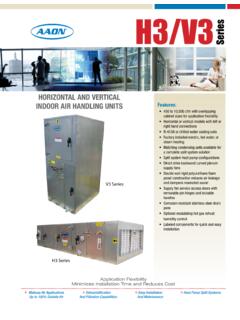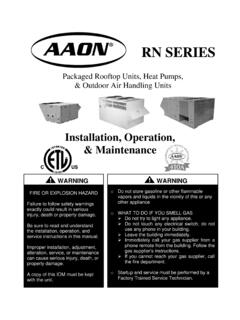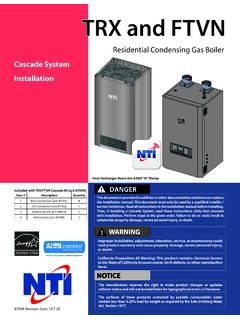Transcription of Outside Air Ventilation - AAON
1 FunctionalityFactory TestingEase of InstallationEase of MaintenanceEnergy EfficiencyAAON 2425 South Yukon Avenue Tulsa, Oklahoma 74107 (918) 583-2266 Fax (918) 583-6094 AirVentilationOutside Air VentilationVentilation Air IssuesIssuesAAON SolutionsContaminants - Outside air often contains smog, pollen, spores and other chemicals and MERV 7-14 pleated filters- MERV 11-14 cartridge filters- MERV 13 & 14 bag filters- HEPA filters- MERV 7 pleated, metal mesh, and lint screen pre filters- Option boxes for field installed filtrationExtreme Temperatures - Outside air can reach more extreme high and low temperatures than temperate recirculated indoor Energy recovery wheels, heat pipes, plate heat exchangers, and run around coils- indirect fired stainless steel gas heaters with 100 temperature rise capability - Direct fired stainless steel gas heaters- Option boxes for field installed energy recovery devicesExtreme Relative Humidity - Outside air can have more extreme high and low relative humidity fluctuations than recirculated indoor Total energy recovery wheels- Large capacity cooling coils- Modulating hot gas reheat, return air bypass, mixed air bypass, and the patented Digital Precise Air Control System (D-PAC )
2 - Option boxes for field installed humidifier or humidity controlBuilding Pressurization - Introducing large amounts of Outside air Ventilation will pressurize a On/Off or VFD controlled factory installed power exhaust or power return fans and barometric relief- Energy recovery wheel options with both power return and/or power exhaust fansHigh Initial Cost - Conventional units require expensive field modifications and additions to be capable of handling large amounts of Outside AAON units are engineered to handle large amounts of Outside air- Pre-designed and factory installed Outside air Ventilation application optionsHigh Operating Cost - Energy is required to constantly heat, cool, and dehumidify Ventilation Outside air, which has a frequently changing Energy recovery wheels, heat pipes, plate heat exchangers, and run around coils- Multiple compressor and Digital Scroll Compressor units- Modulating gas heat (Direct and indirect ), SCR electric heat- Return air bypass, mixed air bypass, and the patented Digital Precise Air Control System (D-PAC )- Chilled water, hot water, and steam coils capable of capacity modulationUnit Corrosion - Extreme temperatures, humidity and Outside air containments in the unit air stream can corrode the interior of the Cooling and heating coil polymer e-coating- Double wall construction- Interior corrosion protection option- Stainless steel condensate drain pans- Stainless steel gas heat exchangersCoil Freezing - Low ambient temperatures and low air flows can cause coil Energy recovery wheels, heat pipes, plate heat exchangers, and run around coils- Interlaced coil circuitry- Hot gas bypass and freeze stats- Steam distributing (dual-tube)
3 Heating coils- Preheat coilsNon-Standard Control Requirements - Ventilation units require non-standard temperature and humidity control sequences. Integration of the units with a building automation system is usually Factory installed make up air controller options- Interoperable controllers- Factory installed controls by others- Field installed controls by othersCommercial buildings today are required by building codes to provide Outside air Ventilation while occupied. ASHRAE Standard , Ventilation for Acceptable Indoor Air Quality, provides guidelines for calculating the minimum amount of Outside air Ventilation needed. There are many reasons for mechanical Ventilation requirements. First, modern commercial buildings are built with inoperable windows, well insulated and air tight (less leakage and infiltration) for more energy efficient operation. Second, commercial spaces tend to produce volatile organic compounds from the out-gassing of wood, carpeting, paint, and plastics used in the construction and furnishing of the buildings.
4 Third, commercial spaces are usually heavily occupied creating high CO2 levels. Fourth, commercial buildings often include some form of space pressure control and thus need Ventilation air to replace exhausted indoor air. Fifth, commercial buildings may be seeking LEED certification, which awards credits for exceeding standard Ventilation requirements. In addition, there can be other reasons a building may need Outside air Ventilation air that are more specific to the building s use, location, and air Ventilation can be added to commercial building spaces with standard heating and cooling units with both return and Outside air or with separate make up air units that introduce 100% Outside air. AAON provides equipment solutions for Air Ventilation Requirements, Issues, and SolutionsOutside Air Ventilation Energy Recovery Wheels capture energy from the exhaust air to pre-cool, pre-heat, humidify, and dehumidify the Outside air (depending on the type of wheel and application).
5 This will decrease a Ventilation unit s peak sensible and latent loads, usually resulting in the need for a smaller tonnage unit that will have less operating cost. The Outside air pre-heating also provides coil freeze protection. Large Capacity Cooling Coils, with their increased depth, provide more dehumidification versus standard coils because the air can transfer more heat while flowing through the coil and thus has a greater chance to reach its dew point. Modulating Gas Heat and SCR Electric Heat modulate their heating capacity to provide consistent supply air temperature without temperature swings. Operating costs are reduced during heating because only the necessary amount of heat will be used to match the load. Modulating Hot Gas Reheat provides dehumidification without overcooling when the space/ Outside humidity is above setpoint. The modulating valves prevent overcooling and supply air temperature swings by reheating the supply air only the necessary amount during dehumidification.
6 Digital Scroll TM Compressors modulate their cooling capacity to provide consistent supply air temperature. Operating costs are reduced during mechanical cooling and dehumidification (with modulating hot gas reheat) because the compressor reduces its power consumption as it modulates to satisfy the reduced Standard Standard 62, Ventilation for Acceptable Indoor Air Quality, was first published in 1973. The standard gave minimum and recommended Outside air flow Ventilation rates to maintain acceptable indoor air quality. After the energy crisis of the 1970 s, in 1981, the standard was republished with the minimum Outside air flow Ventilation rates lowered. This was an attempt to conserve energy consumed by the HVAC system while heating and cooling unnecessary Ventilation air. The standard also added Ventilation rates for both smoking and non-smoking spaces and recommendations on using CO2 ppm levels to determine necessary Ventilation .
7 In 1989, Standard 62 was republished with the minimum Outside air flow Ventilation rates raised to roughly 15-20 CFM per person. This was in response to occurrences of Sick Building Syndrome from inadequate Ventilation throughout the 1980 s. In 2004 the standard was republished as Standard The standard was changed from 62 to because a new Standard Ventilation and Acceptable Indoor Air Quality in Low-Rise Residential Buildings was developed. There were some major changes to ASHRAE Standard The Ventilation Rate Procedure now requires that outdoor air quantities be calculated for each zone. For example, if make up air units are used, the volume of Outside air required must be based on the sum of outdoor air required for each zone the make up air unit serves. Also, many zones now require calculation based on both occupancy (CFM/Person) and square footage. This allows for outdoor air requirements based on both human bioeffluent levels (ppm of CO2) and out-gassing from building materials.
8 Thus, the use of CO2 ppm levels only for Ventilation rates has also been removed. Smoking areas now require more than the minimum amount of Outside air required for non-smoking areas and cannot recirculate their return air to non-smoking areas, however, specific Ventilation rate requirements are no longer given for smoking areas. The objective of the changes made to Ventilation rate calculations in Standard was to give a better estimation of the Ventilation needed for different types of AAON equipment can contribute to three LEED for New Construction credits that relate to building Ventilation . These credits require as a prerequisite that the ASHRAE standard be met. The first credit is for outdoor air delivery monitoring. AAON can provide Outside air monitoring with the Constant Volume Outside Air op-tion and CO2 Override option. The second credit is for exceeding minimum outdoor air requirements.
9 AAON units can be specified with up to 100% Outside air. The third credit is for minimizing occupant s exposure to hazardous particles and pollutants. AAON can provide factory installed power exhaust and high efficiency filters including 95% efficient, MERV 14 GuidelinesAAON has been designing and building Ventilation and make up air equipment since its incorporation in 1987. This experience has allowed AAON to develop many Ventilation specific solutions which can help control the temperature and humidity of the Outside air in the most energy efficient manner Air VentilationIt is the intent of AAON to provide accurate up-to-date specification data. However, in the interest of ongoing product improvement, AAON, Inc. reserves the right to change specifications and/or design of any product without notice, obligation, or liability. AAON products are covered by one or more of the following patents: 5,738,167; 5,826,641; 5,839,505; 6,715,312; 6,792,767, 6,802,543, 6,929,452.
10 AAON and AAONAIRE are registered trademarks of AAON, Inc. D-PAC and AAONEcat32 are trademarks of AAON, Inc. Heatflow and AAON Suite are trademarks of AAON Coil Products, R60120 071010 AAON Environmentally Friendly HVAC Product FamilyCustomer Commitment AAON encourages environmentally responsible design by incorporating many energy saving features into our superior heating and cooling products. In addition to energy efficiency, AAON also offers environmentally friendly R-410A refrigerant capability in all our cooling and heat pump equip-ment. As countries throughout the world phase out CFC and HCFC refrigerants, R-410A is becoming the global standard and AAON is leading the way!Rooftop Units2 - 5 Tons2 - 30 Tons26 - 70 Tons45 - 230 TonsCondensing Units2 - 5 Tons45 - 230 Tons8 - 40 TonsAir-Cooled or Evaporative-Cooled Chiller35 - 365 TonsBoiler500 - 6,000 MBHC ustom Indoor or Outdoor Air Handling Units1,500 - 218,000 CFM indirect Fired1,500 - 120,000+ CFM1,500 - 100,000+ CFMD irect Fired18,000 - 68,000 CFM10,400 - 28,000 CFM800 - 12,000 CFM800 - 2,000 CFMO utdoor Air Handling UnitsIndoor Air Handling Units1,000 - 16,000 CFM16,000 - 51,500 CFM800 - 10,000 CFM800 - 2,000 CFM





